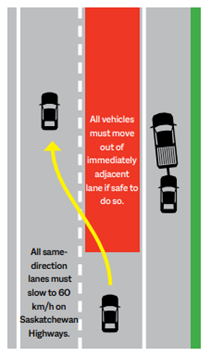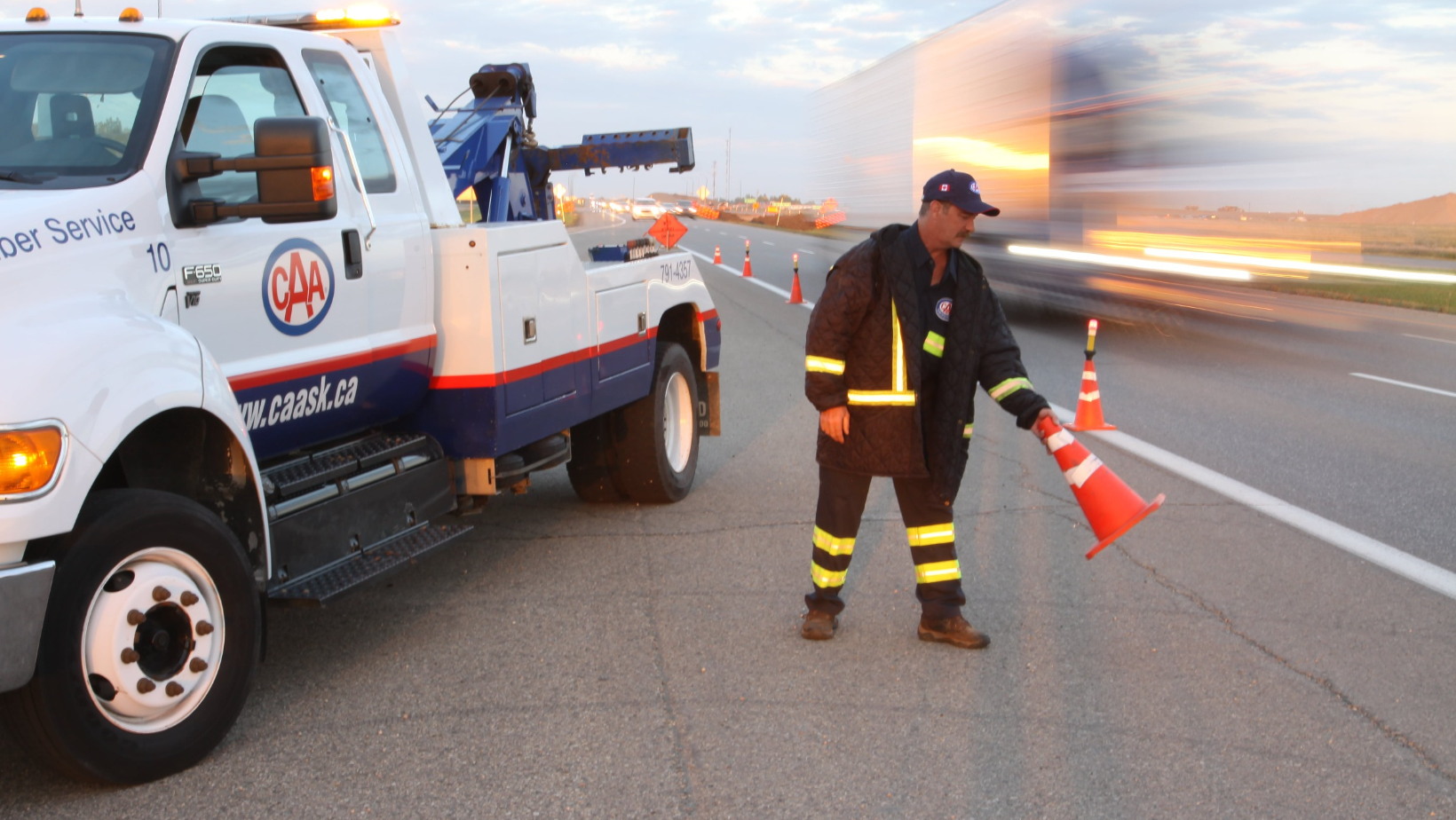While on the road, it's not just our journey that matters. It's the safety of everyone sharing the road. In an increasingly busy world, it's crucial that we take a moment to prioritize the well-being of others too. That's why CAA Saskatchewan is so committed to Road Safety.
And one way of ensuring that is for motorists to reduce their speed and change lanes (if safe to do so) when approaching first responders including tow truck operators, paramedics, law enforcement, firefighters, patrol staff, and construction crews working on our highways. This simple safety act can make a world of difference by preventing potential accidents and fatalities while demonstrating respect and consideration for the dedicated professionals who ensure our safety.
Failing to slow down and move over can have dire consequences.
The lives of emergency personnel are at risk each time they respond to a call or assist a stranded motorist. By neglecting to adhere to this principle, we put these individuals in harm's way.
Across North America, nearly 100 tow truck drivers are killed every year after being struck by oncoming vehicles while helping stranded motorists with flat tires, breakdowns, and collisions.
Unfortunately, this happened in Saskatchewan as well.
In 2017, CAA tow truck operator Courtney Schaefer tragically died after being struck by a semi-truck on the side of the highway near Esterhazy while assisting a motorist who called for help.
And there are also countless near misses that tow truck operators endure daily.
Dave Wiwchar, a fleet manager at CAA Saskatchewan, based in Regina, experienced one while picking up a Member’s Ford F-150 on Highway 1 between Regina and Grand Coulee.
“I had the Member get out of the truck and stand in the ditch while I picked up his vehicle,” recalls Wiwchar. “After securing the passenger side, I went around to the driver’s side to do the same. As I was doing this, a semi came very close, and the wind drag blew me over onto the pavement. The Member came running around the truck as he thought I got struck.”
Stephen Romans, a CAA Regina Fleet tow truck operator describes a harrowing experience.
“We were called out to help a CAA Member with a flat tire on their car. It was a busy road, so another colleague assisted me. I was driving a flat deck truck and was in front of the car and the battery service truck was behind the car. We had our lights flashing and safety cones out. I was busy changing the tire and the other tow truck operator was watching for oncoming vehicles. I could hear him yell STOP, so I quickly stood up and I moved back to see what was going on. A car heading in our direction came very close to hitting the battery service truck. And, to make it even more scary, there was a transport truck tailgating the car. They both came dangerously close to hitting the battery truck and possibly me too.”
Kurt Elmer, a CAA Regina Fleet tow truck operator, had a close call when he was out helping a CAA Member whose car was in the ditch.
“There was poor visibility, strong winds, and it was very icy. We took extra precautions and two of us went out together. I was watching for the oncoming traffic, and the other operator was getting the car ready to tow. As a car approached, I waved my arms while holding the LED flares directing the driver to merge over. I slipped and fell and was lying there helpless with a car coming towards me. I braced myself and I heard the car hit the ditch. I got up and headed towards the vehicle. The driver was shaken but not injured. It turns out he fell asleep. He woke up in a daze and swerved into the ditch - he didn’t even see me. I was so thankful everyone was safe. On the ride back to the city, the CAA Member burst into tears and thanked us for the risks that we put ourselves through every day and said that seeing it firsthand was a real eye opener on what we go through.
CAA Saskatchewan has long advocated for the protection of roadside assistance workers through Slow Down Move Over legislation.
Schaefer’s death also helped push legislative change in Saskatchewan that allows for the use of blue and amber lights on tow trucks, as well as fines for motorists driving faster than 60 km/h when passing emergency vehicles and first responders on the highway.
CAA Saskatchewan annually recognizes the second Tuesday in May as CAA Slow Down Move Over Day to bring attention to this important safety issue. But at CAA, every day should be Slow Down Move Over Day to help keep everyone sale on our busy roads and highways.
How to practice "Slow Down Move Over"
Implementing the "Slow Down Move Over" principle is relatively straightforward, yet its impact can be immense. Here are some key steps to follow:
Reduce Speed
As you approach a stopped first responder vehicle, decrease your speed to 60 km/h on Saskatchewan highways. Slowing down allows you to react effectively to any unexpected situations that may arise.
Change Lanes
When passing a stopped vehicle, move to the lane farthest away from it, if it is safe to do so.

This provides a safety buffer and minimizes the risk of collisions. Remember, it's not just a legal obligation; it's an act of safety, kindness, and consideration.
Be Alert and Aware
Always stay vigilant and scan the road ahead for any signs of first responder vehicles.
Watch for flashing lights, reflective vests, and other indicators that signal the presence of first responders helping motorists and construction crews working on the roadside.
Educate Others
Spread awareness about the "Slow Down Move Over" principle among your friends, family, and colleagues. Encourage them to join the cause and be part of the collective effort to enhance road safety.
We urge you to know the risks because it truly is a matter of life and death. To learn more about the Slow Down Move Over safety message, visit us at caask.ca/slowdownmoveover.
Safety Cloud © HAAS Alert system for CAA Regina Fleet
For added safety, the HAAS Alert system has been implemented for the CAA Regina Fleet tow truck operators. The system sends a warning message of “CAA Saskatchewan On Scene Slow Down and Move Over” to motorists who have the Waze app, as well as vehicles covered by the Stellantis Group OEM which is Dodge, Jeep, RAM, Chrysler, and Alfa Romeo. The alerts are specific to CAA Member rescue calls but will be visible to anyone who uses the platforms.

